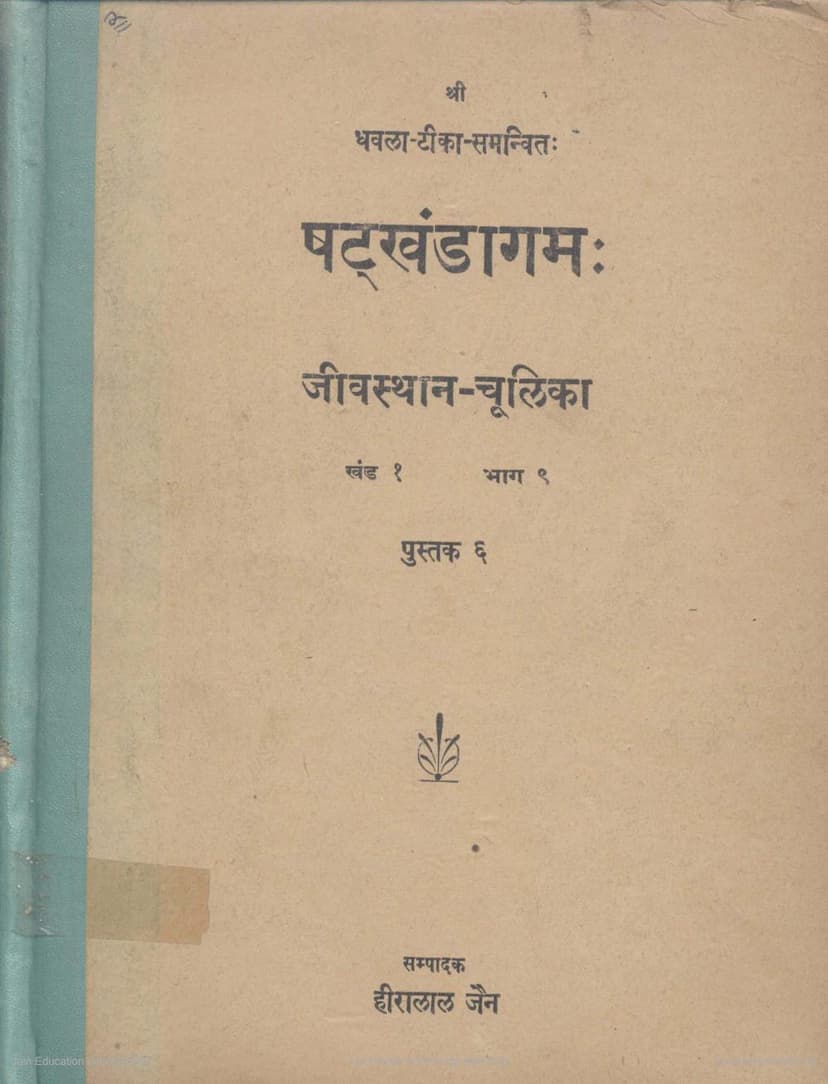Shatkhandagama Pustak 06
Added to library: September 2, 2025

Summary
The provided text is a substantial portion of the Shatkhandagama, specifically Pustak 06, which is part of the Jivathana Khanda. This volume, with the Dhavala commentary, focuses on the Chulika (supplementary) sections of the Jivathana Khanda. It was compiled and edited by Hiralal Jain with assistance from Pandit Balchandra Siddhanta Shastri and cooperation from Pandit Devakinandan and Dr. A. N. Upadhye. Published in 1943 by the Jaina Sahityoddharak Fund Karyalay, Amravati.
The Shatkhandagama is a foundational text in Jainism, delving into the intricacies of karma theory and the soul's journey. This particular volume, Pustak 06, the Chulika section of the Jivathana Khanda, is particularly detailed, covering nine supplementary topics that elaborate on the soul's positions and karmic bondage.
Here's a comprehensive summary of the content, based on the provided pages:
Overall Scope and Structure:
- Book Title: Shatkhandagama Pustak 06
- Author: Pushpadanta and Bhutabali (original authors), with extensive commentary by Virasena (Dhavala Tika) and editorship by Hiralal Jain, Balchandra Siddhanta Shastri, Devakinandan, and A. N. Upadhye.
- Publisher: Jaina Sahityoddharak Fund Karyalay, Amravati.
- Year: 1943 (Veer Nirvana Samvat 2470).
- Focus: The Chulika (supplementary) sections of the Jivathana Khanda (Soul-Positions), with the comprehensive Dhavala commentary.
Key Sections (Nine Chulikas):
The volume is structured around nine supplementary discussions (Chulikas) that expand upon the main topics of the Jivathana Khanda. These are:
- Prakriti Samutkirtana Chulika: This section enumerates the eight primary karmic substances (prakritis) and their subdivisions, totaling 148. It details how these karmas (like Jnanavarniya, Darshanavarniya, Vedaniya, Mohaniya, Ayush, Nama, Gotra, and Antaraya) obstruct the soul's natural qualities, with specific counts for their sub-varieties (e.g., Jnanavarniya has 5, Darshanavarniya has 9, Nama karma has 93 varieties).
- Sthana Samutkirtana Chulika: This part explains which karmic subdivisions can be simultaneously bound and under what conditions, linking them to the 14 spiritual stages (gunasthanas). It details how many varieties of each karma can be contracted at different stages.
- Maha-dandaka (Three Sections):
- First Maha-dandaka: Classifies karmas based on whether they are contracted or not by a soul about to attain Right Faith (Samyaktva), detailing the stages of decreasing bondage.
- Second Maha-dandaka: Enumerates the karmas that beings in hell or heaven (except the seventh hell) might bind when approaching Right Faith.
- Third Maha-dandaka: Enumerate the karmas that a being in the seventh hell might bind on the point of acquiring Samyaktva.
- Utkristha Sthiti Chulika: This section details the maximum duration (sthiti) for which each karma, once bound, can subsist and the period before it bears fruit (abadha). It provides maximum durations for various karmas, ranging from enormous periods for Darshana Mohaniya (70 kodakodi sagaropamas) down to shorter ones.
- Jaghanya Sthiti Chulika: This contrasts with the previous section by outlining the minimum periods for which different karmas can subsist, varying from less than one sagaropama for Darshana Mohaniya to a few avalikas for the shortest-lived beings.
- Samyaktvot patti Chulika: This is considered the "lifeblood" of the work, meticulously describing how Right Faith (Samyaktva) is attained. It details the process of self-purification, the transformation of ignorance into enlightenment, and the eventual destruction or pacification (kshaya or upashama) of deluding karmas. It highlights that the first attainment of Right Faith is often temporary, but subsequent efforts, especially those involving destruction rather than mere pacification of karmas, lead to sustained spiritual progress and eventual perfection. The commentary by Virasena on this section is noted as exceptionally detailed and mathematically precise.
- Gati-Agati Chulika: This ninth chulika primarily deals with the soul's migratory processes (gati). It explains how right attitude (Samyaktva) influences these migrations and discusses the four sources through which it is generated (sight of Jinabimba, listening to discourse, memory of past lives, experiencing present suffering). It also covers which spiritual grades allow entry into or exit from specific states of existence, emphasizing that a being with Right Faith will not enter lower hells or become a lower animal. Finally, it touches upon the virtues or status acquirable in the next birth based on the present life.
Additional Content:
- Prakarana (Introduction/Preface): The initial pages provide a preface by the editor, Hiralal Jain, explaining the delay in publication due to the Chulika being extensive and its subject matter being subtle. It also mentions the impact of the war on printing and the planned continuation with the next volume covering Khudda Bandha.
- Shanka-Samadhan (Questions and Answers): Several pages are dedicated to a Q&A section, addressing various doubts and discrepancies found in the text or interpretations, often referring to other Jain texts like Gommatasara and offering detailed explanations from the Dhavala commentary.
- Tables and Indexes: The volume is supplemented with various indexes, including a sutra text, a list of quotations (Avatara Gatha Suchi), legal pronouncements (Nyayoktiyan), references to other works (Granthollekha), a glossary of technical terms (Paribhashik Shabd Suchi), and special notes (Vishesh Tappan).
- Corrigenda (Shuddhipatra): A section lists corrections for errors found in Volumes 1-6 of the Shatkhandagama series.
Theological and Philosophical Concepts:
The text, through its detailed enumeration of karmic natures, durations, and transitions, deeply explores:
- Karma Theory: The multifaceted nature of karma, its classification, bondage, fruition, and the soul's entanglement with matter.
- Soul's Journey: The path of spiritual progress, the role of Right Faith (Samyaktva), and the ultimate goal of liberation (moksha) through the destruction of karmic impurities.
- Spiritual Stages (Gunasthanas): The classification of souls and their karmic states according to the 14 spiritual stages.
- Causality: The detailed causal links between actions, karmic energies, and the soul's experiences and rebirths.
- Time Measurement: The Jain cosmology's unique and vast time-spans (sagaropama, palya).
In essence, Shatkhandagama Pustak 06 (Dhavala Tika) is an exhaustive treatise on the supplementary aspects of soul-positions and karma, offering a profound understanding of the Jain path to liberation through meticulous analysis and commentary.